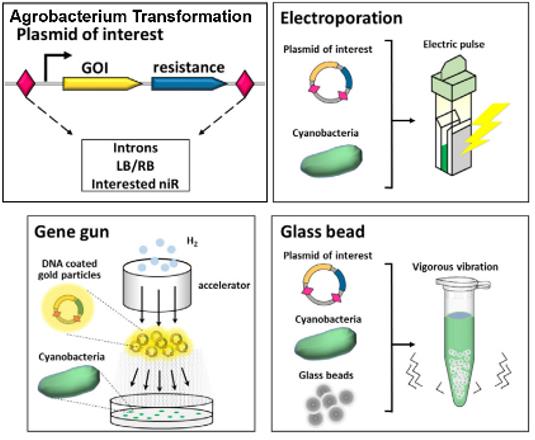Nuclear Transformation Service for Algae
Since a large number of high-value chemicals can be extracted from eukaryotic microalgae, nuclear gene engineering editing techniques in algae are an important method to facilitate the expression of exogenous genes in algal cells and increase production.
Lifeasible has been working on engineering in algae for many years and has accumulated proven and efficient technology to provide quality nuclear transformation services for algae.

Generation of Protoplasts
The algal cell wall is a physical barrier that prevents the entry of foreign DNA through the cell membrane. Therefore, many transformation protocols depend on the use of protoplasts without cell walls. However, in many cases, the generation of protoplasts is a major bottleneck because of the different cell wall compositions of different algal species.
Gene Delivery Methods for Algae Nuclear Transformation
There are four commonly used methods for nuclear transfection of algal cells, namely Agrobacterium-mediated transformation, electroporation, gene gun and inert particle-mediated transformation.
 Fig.1 Genetic elements for eukaryotic microalgae. (Lin, W. R., et al., 2019, Bioresource technology)
Fig.1 Genetic elements for eukaryotic microalgae. (Lin, W. R., et al., 2019, Bioresource technology)
 Agrobacterium Mediated Transformation
Agrobacterium Mediated Transformation
Agrobacterium tumefaciens is a plant pathogen that has been widely used for the genetic engineering of plants due to its ability to transfer DNA to plant hosts. As a highly popular system of nuclear transformation of land plants, Agrobacterium tumefaciens has also been adapted for the transformation of microalgae. Transformed plants and microalgae containing the selectable marker and the transgene, are grown on media containing antibiotics.
 Electroporation
Electroporation
The application of electrical pulses is a common method for introducing DNA into microalgal protoplasts, microalgae with reduced cell walls, and other thin-walled algal cells. Reducing the thickness of the cell wall improves the transformation of microalgae by electroporation techniques. Microalgal cell suspensions are placed in a cuvette along with DNA and an electric field is applied with an electroporator. The electrical pulse causes the formation of pores in the plasma membrane, which allows DNA to enter the cells. Electroporation is a rapid process that allows microalgae to be transformed rapidly.
 Gene Gun
Gene Gun
The most frequently used method of gene delivery is gene gun, also referred to as micro-projectile bombardment, which utilizes exogenous DNA-coated gold or tungsten micro-particles that are delivered through a particle delivery system at high velocity into algal cells, surpassing the physiological barrier of the cell wall, cytosol, and nucleus.
 Inert Particle Mediated Transformation
Inert Particle Mediated Transformation
One method of microalgal transformation that does not require the use of sophisticated equipment is the use of inert particles to deliver exogenous DNA into the cells. A simple method commonly used for gene delivery is to vortex protoplasts or cell wall-deficient mutants in the presence of glass beads, polyethylene glycol (PEG), and exogenous DNA. Higher transformation efficiency can be obtained using microalgae with thin or no cell walls.
Our Services
As a trustworthy CRO company, Lifeasible offers a variety of types of algae nuclear transformation services, which include but are not limited to the following four proven types of algae nuclear transformation services.
- Agrobacterium Mediated Transformation - Foreign genes, together with selectable markers for plants or microalgae, are cloned into T-DNA regions flanked by border repeat sequences, and Agrobacterium is induced to algal cells.
- Electroporation Mediated Transformation - Electroporation is an efficient process that introduces DNA into microalgal protoplasts by electrical pulses.
- Gene Gun Mediated Transformation - Gene gun can transform the exogenous DNA into the nucleus of algae by a particle delivery system at high velocity.
- Inert Particle Mediated Transformation - Inert particle mediated transformation can conduct nuclear transformation by vortexing protoplasts together with glass beads.
Why Choose Us

Our company has a team of professional scientists to support the nuclear transformation service of eukaryotic algae. Please contact us for more information.
Reference
- Lin, W. R., Tan, S. I., Hsiang, C. C., Sung, P. K., & Ng, I. S. (2019). Challenges and opportunity of recent genome editing and multi-omics in cyanobacteria and microalgae for biorefinery. Bioresource technology, 291, 121932.
Our services are for research use only and not for any clinical use.